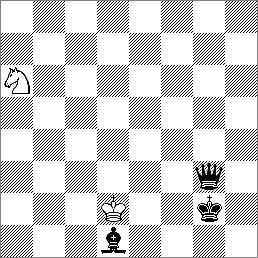
A helpmate is a kind of chess problem in which black moves first and helps white to checkmate him within a specified number of moves. In a helpmate in two (sometimes abbreviated to h#2), for example, the solution consists of a black move, a white move, a black move, and then another white move, giving checkmate. It should be noted that although the two sides are cooperating, all moves must be legal according to the rules of chess.

The example problem to the right is a helpmate in eight by Z. Maslar, published in Die Schwalbe in 1981. The solution is:
1.Kf3 Kd3 2.Bb3 Kc3 3.Ke4+ Kd2 4.Kd4 Ke2 5.Kc3 Nb4 6.Kb2 Kd2 7.Ka1 Kc1 8.Ba2 Nc2#
Note that in helpmate solutions, black's move is given first, which is the opposite to normal algebraic notation.
Because the nature of helpmates sees black and white cooperating, the play in helpmates can be a great deal simpler than in directmates (the most common type of problem, where white tries to checkmate black, and black tries to avoid being mated). In directmates a great variety of play can be found in the solution because although white has only one move at each juncture which will solve the problem, black can chose between several to try and thwart white's efforts. In helpmates, however, both white and black's moves are limited to just one at each juncture.
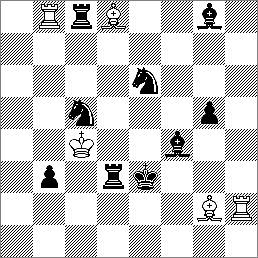
In order to introduce more lines of play into a problem, various devices can be employed. Most straight-forwardly, a problem can have more than one solution. The solutions will usually complement each other in some way, either by being analogous or by completely contrasting. Each solution can be considered a different phase of play (see chess problem terminology). If there is more than one solution, the composer will state this; if there is no such statement, the problem has only one solution. The example to the left is a helpmate in two with two solutions. It was published in the June 1975 issue of Schach and is by the helpmate specialist, Chris Feather.
The two solutions are 1.Bxb8 Bd5 2.Nc7 Bxg5# and 1.Rdxd8 Bc6 2.Nd7 Rxb3#. These lines are very closely linked, with both having the same basic pattern: first black takes the white piece that gives mate in the other solution (this is known as a Zilahi), at the same time opening the line on which mate is eventually given, then white moves a bishop to close a line so that black's next move will not give check. Black's second move closes another line so that after white's last move, the mate, black will not be able to interpose one of his pieces.
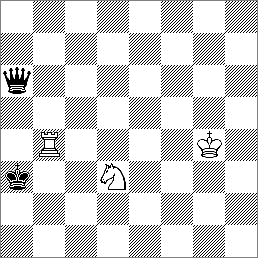
Another way of giving variety to the play of a helpmate is twinning. Here, more than one problem is wrought from a single diagram by making small changes to it, such as moving a piece from one square to another, adding or removing a piece, turning the board round or some other device. Twinning is occasionally found in other types of problems, but is particularly common in helpmates. The example to the right is a helpmate in two by Henry Forsberg (published in 1935 in Revista Romana de Sah 1935). The twins are created by substituting the black queen on a6 with a different piece. The solutions are:
diagram position: 1.Qf6 Nc5 2.Qb2 Ra4#
with black rook at a6: 1.Rb6 Rb1 2.Rb3 Ra1#
with black bishop at a6: 1.Bc4 Ne1 2.Ba2 Nc2#
with black knight at a6: 1.Nc5 Nc1 2.Na4 Rb3#
with black pawn at a6: 1.a5 Rb3 2.Ka4 Nc5#
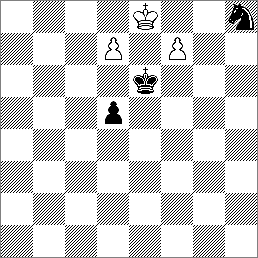
A further variation is the duplex, another way of getting two problems for the price of one. The first problem is a normal helpmate, the second is from the same position but has white moving first and helping black to checkmate him. Again, duplex problems have been composed with other types of problems, but the vast majority are helpmates. To the left is an example by Milan Vukcevich (from CHM avec 6 pieces Bad Pyrmont, 1996).
The solution with black moving first is 1.Ng6 f8Q 2.Ne5 d8N#. With white moving first it is 1.f8R Nf7 2.d8B Nd6#. These two lines are closely linked, with two white pawn promotions covering the black king's flight squares in the first part and promoted pieces blocking white's flight squares in the second. This problem is an Allumwandlung (pawns are promoted to each of knight, bishop, rook and queen).
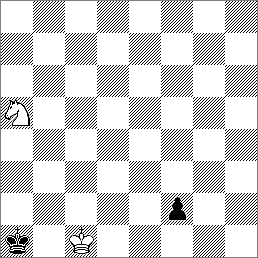
A helpmate may also be a seriesmover, in which black makes a series of moves without reply at the end of which white makes a single move, giving checkmate. Black may not expose his king to check during the series, nor can he check white, except on the last move. To the right is a series-helpmate in seventeen (sometimes abbreviated to ser-h#17) by T. R. Dawson (published in Fairy Chess Review, 1947). An effective way to solve long series-helpmates such as this is to envisage a position in which black could be checkmated, and then try to reach it. Here, with only one knight, the only way to checkmate black is to have the king in the corner and another black piece on a2, allowing Nb3 giving mate. It might seem there are many ways to do this, but the need to avoid exposing the white king to check means there is only one, involving the black king walking half-way over the board and then back again. The solution is:
1.Ka2 2.Ka3 3.Kb4 4.Kc3 5.Kd3 6.Ke2 7.Ke1 8.f1R 9.Rf2 10.Ke2 11.Kd3 12.Kc3 13.Kb4 14.Ka3 15.Ka2 16.Ka1 17.Ra2 Nb3#
Helpmates, like other problems, can be composed with fairy chess pieces or with fairy conditions (chess variant rules), such as circe chess, grid chess or patrol chess. All of these variants can be, and have been, combined - so it is possible to have a series-helpmate in seven, twinned with two solutions in each phase, using nightriders and Madrasi chess.
Chris Feather, Black to Play (F. Chlubna, Vienna, 1994) - a general survey of helpmates